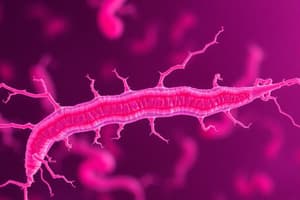Podcast
Questions and Answers
What is the definition of pathogenicity?
What is the definition of pathogenicity?
- The capacity of a microorganism to survive in extreme conditions.
- The ability of a microorganism to reproduce rapidly.
- The capacity of a microorganism to form spores.
- The ability of a microorganism to cause disease by overcoming host defenses. (correct)
Which statement best describes virulence?
Which statement best describes virulence?
- The ability of a microorganism to reproduce within a host.
- The ability of a microorganism to adhere to host tissues.
- A process by which pathogens evade the immune system.
- A measure of the severity and extent of a disease caused by a pathogen. (correct)
Which portal of entry is most frequently associated with respiratory diseases?
Which portal of entry is most frequently associated with respiratory diseases?
- Skin.
- Genitourinary tract.
- Respiratory tract. (correct)
- Gastrointestinal tract.
What are mucous membranes primarily associated with?
What are mucous membranes primarily associated with?
What role does the gastrointestinal tract play in the entry of pathogens?
What role does the gastrointestinal tract play in the entry of pathogens?
How can pathogens penetrate intact skin?
How can pathogens penetrate intact skin?
Which of the following diseases is transmitted through the genitourinary tract?
Which of the following diseases is transmitted through the genitourinary tract?
What is a potential outcome of pathogens damaging host tissues?
What is a potential outcome of pathogens damaging host tissues?
Which bacterial protein is responsible for aiding in attachment and resisting phagocytosis in Streptococcus pyogenes?
Which bacterial protein is responsible for aiding in attachment and resisting phagocytosis in Streptococcus pyogenes?
What enzyme produced by bacteria is responsible for breaking down fibrin clots?
What enzyme produced by bacteria is responsible for breaking down fibrin clots?
Which of the following components helps Mycobacterium tuberculosis resist digestion by phagocytes?
Which of the following components helps Mycobacterium tuberculosis resist digestion by phagocytes?
How do bacteria like Salmonella and E. coli facilitate their entry into host cells?
How do bacteria like Salmonella and E. coli facilitate their entry into host cells?
Which extracellular enzyme aids in the spread of bacterial infections by hydrolyzing hyaluronic acid?
Which extracellular enzyme aids in the spread of bacterial infections by hydrolyzing hyaluronic acid?
What role does collagenase play in bacterial pathogenesis?
What role does collagenase play in bacterial pathogenesis?
What is the main function of the Opa Protein found in Neisseria gonorrhoeae?
What is the main function of the Opa Protein found in Neisseria gonorrhoeae?
Which of the following encapsulated bacteria is not mentioned as contributing to virulence through certain cell wall components?
Which of the following encapsulated bacteria is not mentioned as contributing to virulence through certain cell wall components?
What mechanism does HIV use to evade the immune system?
What mechanism does HIV use to evade the immune system?
Which of the following is a direct result of cytocidal effects by viruses?
Which of the following is a direct result of cytocidal effects by viruses?
What is a noncytocidal effect of viral infection?
What is a noncytocidal effect of viral infection?
Which cytopathic effect is characterized by the fusion of infected cells?
Which cytopathic effect is characterized by the fusion of infected cells?
How do some viruses induce functional changes without visible damage to the host cell?
How do some viruses induce functional changes without visible damage to the host cell?
What role do antigenic changes on cell surfaces play in viral infections?
What role do antigenic changes on cell surfaces play in viral infections?
What potential risk is associated with chromosomal damage induced by some viruses?
What potential risk is associated with chromosomal damage induced by some viruses?
Which process is typically halted by viruses like Simplexvirus?
Which process is typically halted by viruses like Simplexvirus?
Which of the following bacterial pathogens can survive within phagocytes by escaping or inhibiting phagosome-lysosome fusion?
Which of the following bacterial pathogens can survive within phagocytes by escaping or inhibiting phagosome-lysosome fusion?
What is the role of siderophores in pathogenic bacteria?
What is the role of siderophores in pathogenic bacteria?
What is one way that biofilms enhance resistance to phagocytosis?
What is one way that biofilms enhance resistance to phagocytosis?
Which mechanism do microorganisms use to damage host cells by competing for resources?
Which mechanism do microorganisms use to damage host cells by competing for resources?
What type of pathogens require low pH for replication within phagocytes?
What type of pathogens require low pH for replication within phagocytes?
Which of the following is NOT one of the primary mechanisms by which microorganisms damage host cells?
Which of the following is NOT one of the primary mechanisms by which microorganisms damage host cells?
Which pathogen can kill phagocytes and mitigate immune recognition through its biofilm structure?
Which pathogen can kill phagocytes and mitigate immune recognition through its biofilm structure?
How do some pathogenic bacteria directly acquire iron from the host?
How do some pathogenic bacteria directly acquire iron from the host?
What type of interferons do infected cells produce to protect neighboring uninfected cells?
What type of interferons do infected cells produce to protect neighboring uninfected cells?
What is one of the effects of interferons on infected cells?
What is one of the effects of interferons on infected cells?
Which pathogenic property is associated with the toxins produced by fungi such as Fusarium and Stachybotrys?
Which pathogenic property is associated with the toxins produced by fungi such as Fusarium and Stachybotrys?
What mechanism does the protozoan Plasmodium use to cause disease?
What mechanism does the protozoan Plasmodium use to cause disease?
What is one way that protozoa evade host defenses?
What is one way that protozoa evade host defenses?
What virulence factor is produced by Cryptococcus neoformans to resist phagocytosis?
What virulence factor is produced by Cryptococcus neoformans to resist phagocytosis?
Which pathogenic mechanism is NOT typically associated with fungi?
Which pathogenic mechanism is NOT typically associated with fungi?
What is a common outcome of ergotism caused by Claviceps purpurea?
What is a common outcome of ergotism caused by Claviceps purpurea?
Flashcards are hidden until you start studying
Study Notes
Microbial Mechanisms of Pathogenicity
- Pathogenicity is a microorganism's ability to cause disease by overcoming host defenses.
- Virulence is the degree of pathogenicity, indicating how severe the disease can be.
How a Microorganism Enters a Host
- Portals of Entry:
- Mucous Membranes:
- Respiratory tract: Most frequent portal, responsible for numerous infections like common cold, pneumonia, tuberculosis, influenza, and measles.
- Gastrointestinal tract: Pathogens enter through food, water, or contaminated fingers, causing diseases like poliomyelitis, hepatitis A, typhoid fever, and cholera.
- Genitourinary tract: Entry through sexual contact, linked to STIs such as HIV, genital warts, chlamydia, syphilis, and gonorrhea.
- Skin: Largest organ and primary defense against pathogens.
- Unbroken skin is typically impenetrable.
- Microbes can enter through hair follicles, sweat glands, or breaks in the skin like cuts or abrasions.
- Some pathogens can penetrate intact skin, e.g., hookworm larvae.
- Conjunctiva: Mucous membrane covering the eye, susceptible to infections like conjunctivitis and trachoma.
- Mucous Membranes:
How Bacterial Pathogens Penetrate Host Defenses
- Cell Wall Components:
- M Protein: Found in Streptococcus pyogenes, aids in attachment and resists phagocytosis.
- Opa Protein: Present in Neisseria gonorrhoeae, facilitates attachment and entry into host cells.
- Mycolic Acid: In Mycobacterium tuberculosis, helps resist digestion by phagocytes.
- Enzymes:
- Bacteria produce extracellular enzymes (exoenzymes):
- Coagulases: Convert fibrinogen to fibrin, forming clots that protect bacteria from phagocytosis.
- Kinases: Break down fibrin clots (e.g., streptokinase).
- Hyaluronidase: Hydrolyzes hyaluronic acid, aiding tissue spread.
- Collagenase: Breaks down collagen, facilitating spread of infections like gas gangrene.
- Some bacteria produce IgA proteases to destroy IgA antibodies, aiding adherence.
- Bacteria produce extracellular enzymes (exoenzymes):
How Bacterial Pathogens Penetrate Host Defenses: Penetration and Survival
- Penetration:
- Pathogens attach using adhesins, triggering host cell signals for entry.
- Bacteria like Salmonella and E. coli use invasins to rearrange actin filaments in host cells, leading to membrane ruffling and engulfment.
- Once inside, some bacteria (e.g., Shigella, Listeria) can use actin for movement within and between cells.
- Survival Inside Phagocytes:
- Certain pathogens can survive or replicate within phagocytes, like Coxiella burnetii, requiring low pH for replication.
- Others escape or inhibit phagosome-lysosome fusion (e.g., Mycobacterium tuberculosis, HIV).
- Role of Biofilms:
- Biofilms enhance resistance to phagocytosis.
- Phagocytes struggle to penetrate the extracellular polymeric substance (EPS) of biofilms.
- EPS may shield bacterial antigens from immune recognition and can even kill phagocytes (e.g., in Pseudomonas aeruginosa).
How Microorganisms Damage Host Cells
- Using the host's nutrients:
- Most pathogenic bacteria require iron for growth, but free iron levels in the body are low.
- Siderophores: Proteins secreted by bacteria to bind and sequester iron from host iron-transport proteins (e.g., transferrin, lactoferrin).
- The iron-siderophore complex is taken up by bacterial receptors, allowing bacteria to acquire essential iron.
- Causing direct damage at the site of invasion:
- Pathogens can physically damage cells and tissues as they grow and multiply.
- Producing toxins that affect distant sites:
- Exotoxins are proteins secreted by bacteria that can cause damage at sites distant from the infection.
- Endotoxins are components of the bacterial cell wall that are released when the bacteria die or are destroyed by the immune system.
- Inducing hypersensitivity reactions:
- Certain bacterial components or toxins can trigger exaggerated immune responses that can lead to tissue damage.
Pathogenic Properties of Viruses
- HIV Evasion:
- Hides attachment sites, making it difficult for the immune system to detect it.
- It targets CD4 proteins on T lymphocytes, making it hard for antibodies to neutralize the virus.
- Cytopathic Effects (CPE): Viral infections typically lead to host cell death through accumulation of viruses or disruption of cellular functions.
- Cytocidal effects: Directly result in cell death.
- Noncytocidal effects: Cause damage without killing the cell.
Specific Cytopathic Effects of Viruses
- Inhibition of Macromolecular Synthesis: Some viruses halt cellular processes, e.g., Simplexvirus stops mitosis.
- Lysosomal Enzyme Release: Host cell lysosomes release enzymes, leading to cell destruction.
- Inclusion Bodies Formation: Viral components aggregate in infected cells, aiding diagnosis (e.g., Negri bodies in rabies).
- Syncytium Formation: Infected cells may fuse to form large multinucleate cells seen in measles and mumps.
- Functional Changes Without Visible Damage: Example includes measles virus reducing IL-12 production, impairing the immune response.
- Antigenic Changes on Cell Surfaces: Viral proteins alter host cell antigens, prompting immune targeting.
- Chromosomal Damage: Some viruses induce chromosomal breakage or activate oncogenes, leading to cancer risks.
- Cell Transformation: Certain viruses can transform host cells into abnormal growth patterns, losing contact inhibition.
- Interferon Production: Infected cells produce alpha and beta interferons to protect neighboring uninfected cells.
- Interferons inhibit viral and host protein synthesis and induce apoptosis in infected cells.
- Many viruses have mechanisms to evade interferon responses, hindering their effectiveness.
Pathogenic Properties of Fungi, Protozoa, Helminths, and Algae
- Fungi:
- Toxins:
- Trichothecenes: Inhibit protein synthesis and cause headaches, chills, and nausea.
- Ergotism: Caused by Claviceps purpurea, leading to hallucinations and gangrene.
- Virulence Factors:
- Some fungi secrete proteases that modify host cell membranes for attachment.
- Cryptococcus neoformans produces a capsule that resists phagocytosis.
- Resistance to antifungal drugs can occur through decreased receptor synthesis.
- Toxins:
- Protozoa:
- General Characteristics:
- Can cause disease through their presence and waste products.
- Pathogenic Mechanisms:
- Cell Invasion:
- Plasmodium invades red blood cells, causing them to rupture.
- Toxoplasma prevents normal digestion within macrophages, allowing it to grow.
- Giardia intestinalis attaches to host cells and digests tissue fluids.
- Cell Invasion:
- Evasion of Host Defenses: Some protozoa use antigenic variation to evade the immune system (e.g., Trypanosoma changes its surface antigens).
- General Characteristics:
Studying That Suits You
Use AI to generate personalized quizzes and flashcards to suit your learning preferences.



